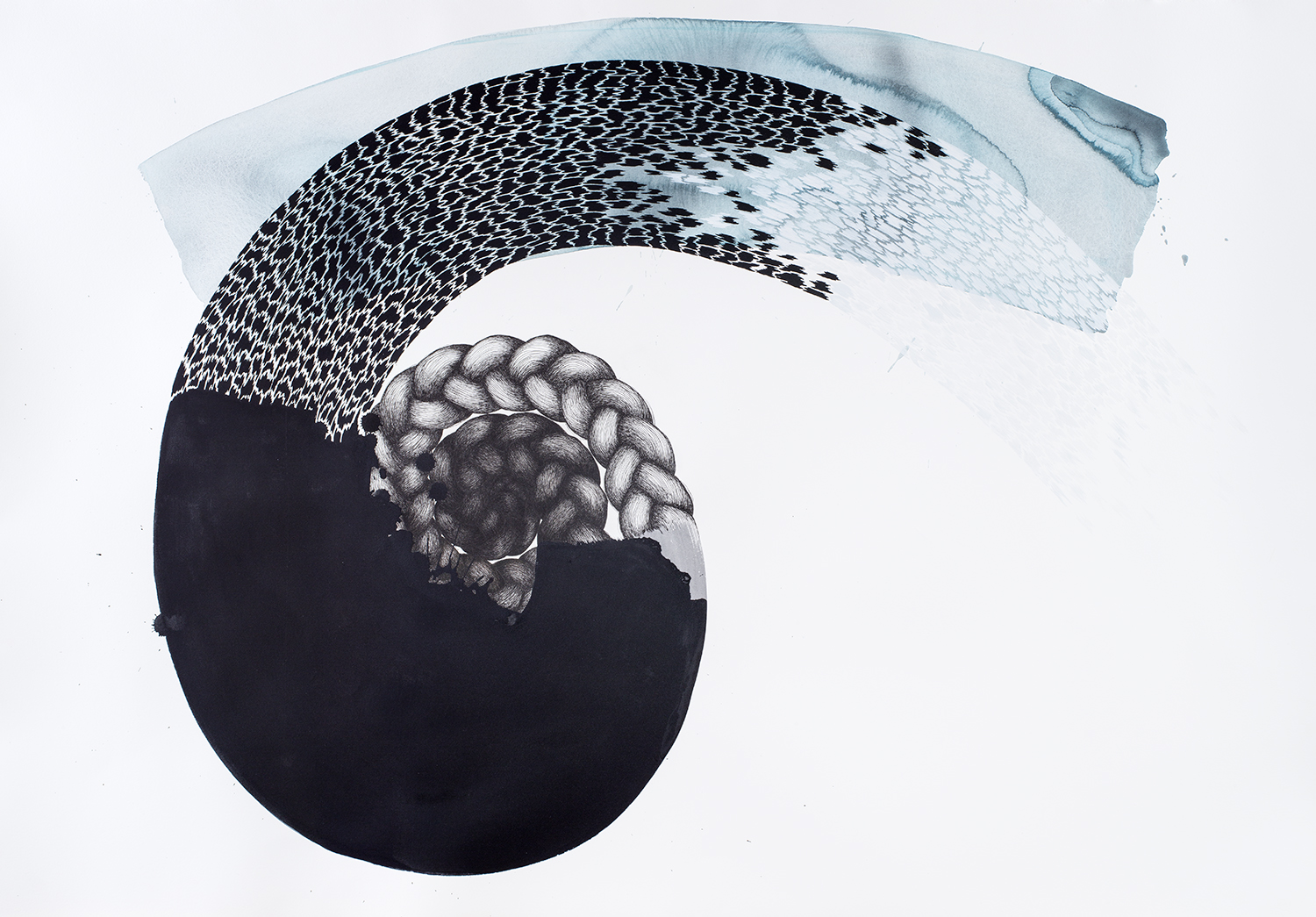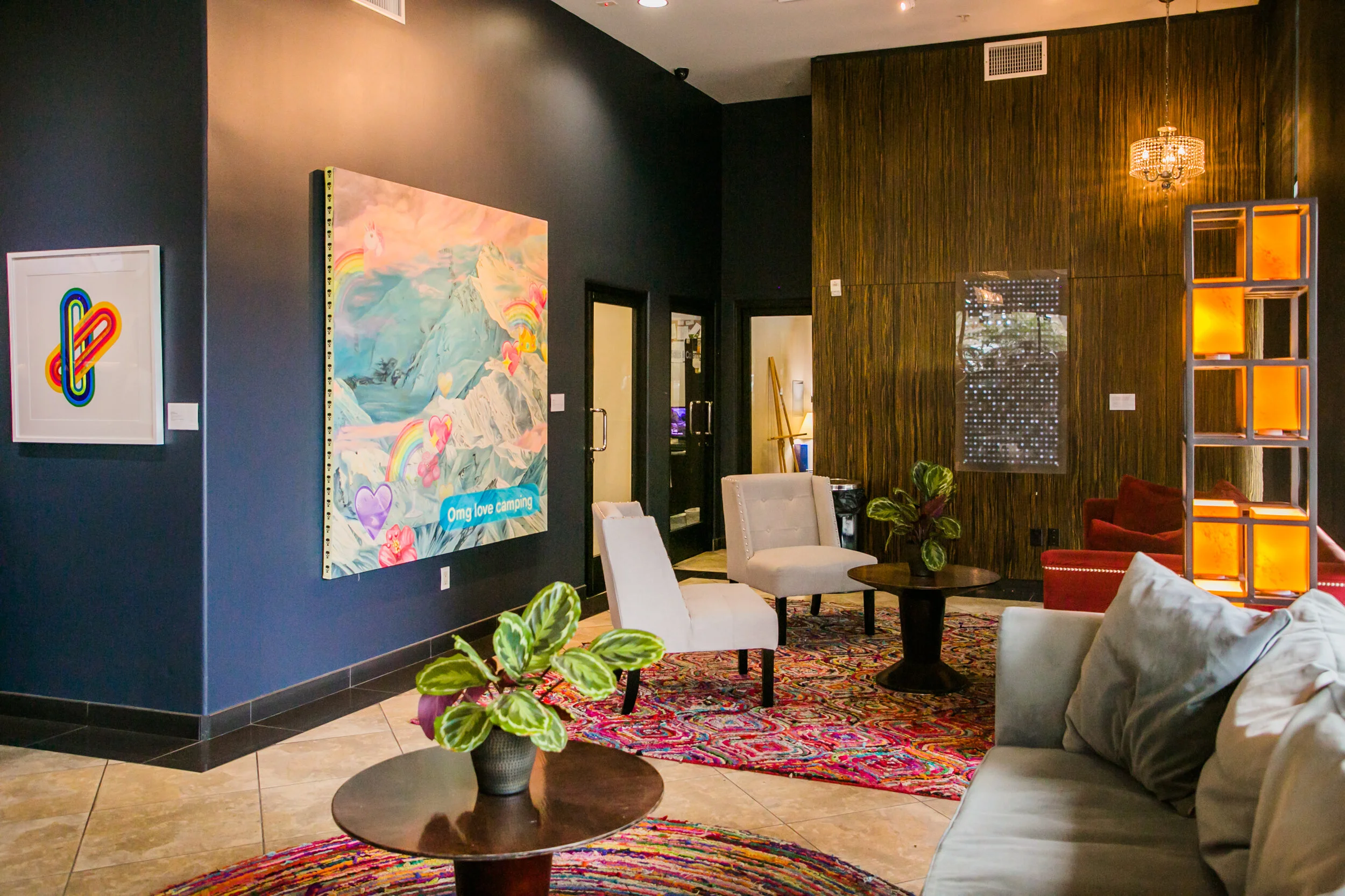JENESSA GOODMAN | PORTO VISTA HOTEL
Jenessa Goodman | Artist Statement
“My artwork is the result of a lifetime of gathering. I take textures and shapes from nature, then reinvent and reorder them. I find images in dreams and archetypal mythology. I study plants, colors, and patterns of human movement. I incorporate synesthesia and allow myself a free hand with the exploration of images. A lot of my work is simply intuitive. For me, creating art is an offering to the collective human experience and a homage to the mystical and spiritual aspects of everyday life.
I’m inspired by the concepts of micro and macro as they relate to nature and to human consciousness. Repetition pulses through composition then changes into something new. Matter is balanced with nothingness. Dreams fascinate me, as does Jungian psychology and the concept of a collective unconscious. I’ve always had an active, vivid dream life, and images from dreams frequently find their way into my work. Through art, I seek to strengthen the links between different realities.
I primarily use ink and gouache on large pieces of watercolor paper. Gouache has a seductive purity of pigment, and the precision of ink balances bold colors. Most of my paintings are fairly large – up to eight feet by ten feet. Working on this scale allows me to create a sense of atmosphere. On closer examination, however, my work is full of tiny detailed patterns that merge and shift and change.
The art I’ve made in the last few years is charged with emotion. It documents the alchemical process of personal growth, change and rebirth.” - Jenessa Goodman
Where are you finding inspiration for your work?
(JG) My brain is like a big visual sponge. This makes me one of those artists whose mind is always so full that it’s more about consistently pouring out the artwork so I can stay sane, rather than actively looking for inspiration. One of the biggest things I consider is whether or not the feelings I want to communicate are represented in the work. In order to do this, I need to have a wide variety of colors, textures, shapes, and themes at my disposal. When I find that a particular color, rhythm, or style of mark-making really resonates, I know that it will be an effective way to express what is filling me up at that moment.
How did the Braid series evolve?
(JG) Braids are meaningful to me in both a personal sense and a collective one. In a broad sense, braids represent many small, disparate parts weaving together in rhythm to form a strong and supple whole. They have a feeling of individuality within a greater pattern of togetherness.
On a personal level, braids were my hairstyle of choice during most of my childhood. I had long, beautiful hair and frequently received compliments on it. However, I was so shy that I asked my parents to braid it up so people would stop noticing me. It took me years to feel comfortable enough to wear it down again. When I began to work with braid imagery, it was a meditation on being seen and being hidden nestled within the larger context of togetherness and individuality.
Do you collect anything?
(JG) I’m a minimalist at heart, but I do tend to gather beautiful items from nature like special rocks, sticks and seashells. Both of my parents were jewelers, so I inherited a love of jewelry. I have a collection of special pieces that were handed down through my family, and I also collect future heirloom jewelry that will be passed down to my own children. I’m lucky to have several friends who are jewelry designers, so I usually buy their pieces. I feel that it’s important for the items with which we adorn ourselves to be meaningful. I also have tons of books!
Can you explain your interest in archetypal mythology?
(JG) Archetypes are essentially clusters of energy that express sets of characteristics. They exist in all human cultures, and tend to be fairly universal - for instance, the archetype of the Trickster exists in most cultures. Archetypes are expressed as recurrent motifs in art, literature and mythology. I believe that they exist in our collective psyche so we humans can attempt to make sense of ourselves. As an artist, it is almost impossible not to have archetypes move through your work and practice in one way or another. Mythology is the expression of archetypal material in story form, and my artwork is a visual expression of story.
Can you explain more about Jungian psychology and how this has been incorporated into your work?
(JG) What I wrote earlier about archetypes touches on this. I would also add that the Jungian concept of individuation is very much present in my work, though more in the process than the end product. I use art as a tool to work through things, and it has been a crucial alchemical element in my personal growth. I believe that, by nature, all creative endeavors help us grow, so it is important to weave creativity into our lives wherever possible.
How does synesthesia influence your practice?
(JG) I’m going to quote Psychology Today here: “Synesthesia is a neurological condition in which stimulation of one sensory or cognitive pathway (e.g., hearing) leads to automatic, involuntary experiences in a second sensory or cognitive pathway (e.g., vision). Simply put, when one sense is activated, another unrelated sense is activated at the same time.” I have synesthesia, and one of the ways I experience it is that any physical sensation elicits a spontaneous visual image – with color, shape, and texture - in my mind. It’s a simple jump to use this visual material when I want to express certain emotions or thoughts in my work. I’m basically seeing a never-ending stream of Technicolor images in my mind’s eye, so why not paint some of them?
What is the last great book you have read that influenced your work? How did it influence your work?
(JG) One of my two favorite books is Palm of the Hand Stories, by the Japanese writer Yasunari Kawabata. It’s a book of short stories so brief that they could fit “in the palm of a hand.” In other words, they are sketches of crystalline moments in time so beautifully expressed that only the minimum amount of words are needed. Very Zen. My other favorite book is Mason & Dixon, by Thomas Pynchon, which is really the opposite. It’s a giant tome full of complicated language and ridiculous humor. I appreciate both the sparseness of the Kawabata book and the saturated, wordy resplendence of the Pynchon one. My work holds both these qualities as well – it is essentially a dance between minimalistic order and jubilant chaos.
Is there a quote that you resonate most with?
(JG)Growing up, my grandmother had many framed quotes all around her house. “To thine own self be true, and it must follow as the night the day, thou canst not then be false to any man,” from Hamlet has been my favorite since I was a kid. I deeply believe that in order for each one of us to contribute meaningfully to this world we need to show up as the most authentic versions of ourselves.
What under-appreciated artist, gallery. or work do you think people should know about?
(JG) More than any one specific person or thing, I think that people need more art in their lives in general! Whether it’s buying affordable art from local artists or becoming involved in your community art scene, participating and enjoying art enriches our lives.
What do you like to do when not creating art?
(JG) I love to dance, cook, sail, swim, hang out with my family, travel, garden, read, take naps, meditate. I also have a regular job that I love – I’m a therapist specializing in creativity and dream work.
Do you listen to music, videos, audiobooks, podcasts while working ?
(JG) I listen to background music when I’m painting or drawing something that requires a lot of attention. When I’m doing something relatively mindless (like endless hours of shading on the braids), I listen to audiobooks. I particularly love historical fiction and noir detective stories.
Name your Top 10 songs on your studio playlist:
My top 10 songs change frequently, but currently they are:
And When I Die – Blood, Sweat & Tears
Each Coming Night – Iron and Wine
You Took My Breath Away – Traveling Wilburys
La Bicicleta – Carlos Vives & Shakira
Past Lives – Langhorne Slim & The Law
Music Like Dirt – Desmond Dekker
Sunken Waltz – Calexico
Somebody to Love – Queen
Dancado Lambada - Kaoma
Those Memories of You – Dolly Parton, Emmylou Harris & Linda Ronstadt
What do you feel most excited or inspired by right now ?
(JG) I’m developing a program that incorporates creativity and psychology. I’m very excited to weave together two of my biggest passions and offer that to others.
What is your daily routine and how do you incorporate time for art making?
(JG) I awaken early but slowly, then write down my dreams. After that I get my kids up and hustle like crazy to get everyone fed, dressed, lunches made, and out the door. After I drop them off, I go to work. My kids do an afterschool program, and my schedule varies. When I finish work I sometimes have a couple hours where I meditate, take a nap if I can, then decide whether I want to hit the never-ending pile of laundry or do some artwork. Sometimes I keep painting and drawing in the evening while the kids are doing homework. As a busy single mom, I really just squeeze artwork in wherever I can – there’s no set schedule. I simply sit down and do it. My studio setup is a room in my house, so that makes it easier. Waiting for the muse to strike and then neglecting everything else while I madly paint in a fit of passion simply isn’t possible for me right now, so I just work with what I’ve got.
One thing I always do is tidy up my work area and pause for a moment to get centered before I start doing artwork. This is a very important step for me, and it has a ritualistic quality. I need to tune in deeply to what I’m doing, even if I only have a short amount of time. I’ve found that art is most powerful when it is created with intention and love.












